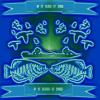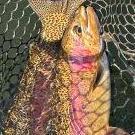To better describe that picture a rock as you straight troll over it your baits will pass on the sides of it in a straight line and be there for a few brief seconds. However if you sharply turn in the right position you will have one bait that hits the front of the rock and then bounces down the entire side of it finally coming off the opposite end keeping your bait in the strike zone a few seconds longer and creating a great deal of commotions triggering a strike that a mere pass by would not. You will lose more lures doing this but you will actually catch more fish doing it.
This is a screen-shot of a rock with crappie on it for examples:
The rock for this purpose goes from 22fow to 17fow you want to swing at the right time to this situation to come over the top of the rock in 9 to 12 fow. Now had you marked fish on the edges of the rock you would want to use a bait designed to run 18 to 20 fow to make contact with the front of the rock and hitting its sides and finally pulling off the back of the rock.
This is straight line trolling, Notice that you come close to the target object but pass by it only presenting the bait to the fringes of its center / largest point.
And here is the tight turn sweep, Note how one bait actually will be making numerous contact hits to the target and the other sweeps much closer. Both allow more time in the strike zone.

2nd is bait selection; what can be said about the vast array of baits we have to us other than mind blowing and confusing! Many baits are what I term as ( for angler sale ) by that I mean they are eye catchers for anglers not fish catchers. Over the years I have found a lure can catch a fish but only a few can catch fish constantly. When I look for a lure I am looking for that bait that works! Not the one that looks pretty. Trial, error and experimentation can be costly and the average angler may not want to spend the money to find those baits. On Beaver and Tablerock I have found 5 baits that work and catch fish on very consistent bases. Below are those baits ( please remember I am trolling these baits and they may not work for other techniques ).
The three on the left are something new I was turned onto, they are from Cabelas and are deep diving 18 to 22fow. The two on the right are the good ole Rapala's Shad rap SR7 to SR9 work very well from 15 to 22 fow
The Flicker shad are what seems to produce great in all conditions and cover a wide variety of depths, Hook Line and Sinker in Rogers is my go to place and they keep a good selection in stock of size and color. It is worth noting Basspro and Cabelas have other colors made for them as well but I have found the ( Pearl White, Black and Silver, Blue Tiger, Black gold and Black Gold Sunset ) work best for trolling.
The final hard bait I like to keep is an assortment of top water baits, I will run one out behind the boat in the early morning and toward dusk attempting to capitalize on surface feeding. There are very limited to that time frame but elicit some of the most voracious attacks.
Keitechs again Hook Line and Sinker is where to get them and they are great for working in shallow 3 to 10 fow is when I use them most deep water they lose a lot of their effectiveness.
Again more keitechs, same usage as the picture above just different style.
3rd is the reel; I don’t just guess how far out I am letting line, I know how far they are out by using line counter reel! This is one area I am not looking for the most expensive reel in the world as Line Counters tend to malfunction commonly on them so I look for the midrange/price reel that can be replaced relatively cheaply when they break. They are absolutely a requirement for precision presentation.
I have been asked how do I know where the baits at? It is actually a simple answer. I find a piece of structure in the water that is at specific depth and mark it with a buoy then I put on a bait that is designed to run at a specific depth and let out line and make passes over it until I tap the top of it with the bait. You will see your rod tip bounce when you hit it. Then make a note of how much line was let out and the boats speed, on your graph take a sharpie and mark on the top or bottom of it ( the hard case not screen ) where on the screen the object is. This will tell you where bites should happen for that bait. At first I suggest writing it down in a log as time goes on you will know by memory. That is the
TV FISHING” I often Joke about. You will actually know when the bite will happen and even after time know what should bite by the way the fish is orientated to cover and how the mark of the fish looked. Granted the quality of your GPS will be of great importance in that but even with the lower end models you will still know about where and when the bite will happen. Good Luck.



.thumb.jpeg.6621b58141f29d040e960100d6323247.jpeg)
.thumb.jpeg.4a325dd68c0a40d05ae019f9bb7e3af7.jpeg)
.thumb.jpeg.1b84f28e4b2a7d26eed371f33117fe2e.jpeg)
.thumb.jpeg.86afee01b6b07b29efd980c3377f4b7a.jpeg)
.thumb.jpeg.bb2f5f448133a80dc398a1a96040fba0.jpeg)
.thumb.jpeg.727c140d96bb0dea6992a8c28e093a38.jpeg)

Recommended Comments
There are no comments to display.
Create an account or sign in to comment
You need to be a member in order to leave a comment
Create an account
Sign up for a new account in our community. It's easy!
Register a new accountSign in
Already have an account? Sign in here.
Sign In Now